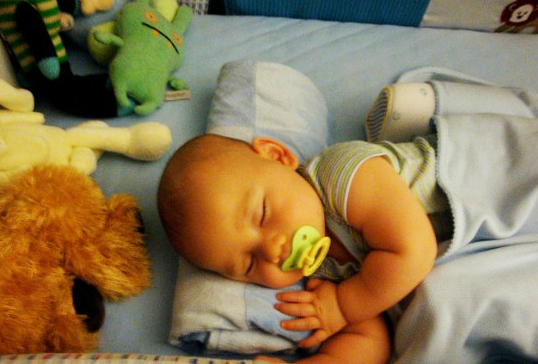If there is one thing that all new parents look for, it is a way to help baby go to sleep and stay asleep! You’ve heard what the experts say: Establish a regular bedtime routine and teach your baby to fall asleep on her own. Then, within a few days or weeks, you too will have a baby who sleeps through the night. This sounds great, but parents often start wondering if it really does work.

Image source: Flickr
When first born, the “inner clock” of a newborn baby is not in sync with the 24-hour day. For the first six to eight, maybe even twelve weeks, most babies aren’t able to stay up much longer than two hours at a time, they will constantly be sleeping and waking. At this age there is little point in trying to control their sleep, other than gently encouraging daytime wakefulness and nighttime sleep. After those first weeks, however, babies begin to develop circadian rhythms—-the cyclical, physiological changes that keep us tuned into the natural progression from morning to night (Rikvees 2003). Regardless, it is never too early to begin finding what works to help baby fall and stay asleep.
Below are several tips from parents that have been found to help baby fall asleep, and eventually, stay asleep. But first, a few tips to remember. First of all, sleep is not a state you can force your baby into, it must naturally overtake your baby. Secondly, what works for one family may not work for you, so do what’s best for you and your baby. And finally, keep in mind that what doesn’t work one week may work the next – it all depends on the different stages in your baby’s development.
1. Daytime Mellowing
A calm, peaceful daytime is more likely to lead to a restful night than an over-stimulating day. Some experts believe that the more attached you are to your baby during the day and the more baby is held and calmed during the day, the more likely this peacefulness is to carry through into the night. Of course you always want to stimulate your baby during the day. Interact and provide learning experiences, but as the days draws to an end, beginning in the late afternoon, start providing more calming activities and experiences.
2. Consistent Bedtimes and Rituals
Nothing is quite as important that providing a consistent bedtime routine and schedule. Babies who enjoy consistent bedtimes and familiar going-to-sleep rituals are more likely to go to sleep easier and stay asleep longer. Familiar bedtime rituals set baby up for sleep. The sequence of a warm bath, rocking, nursing, lullabies, etc. set the baby up to feel that sleep is expected to follow.
3. Calming Down
Many parents find that giving their baby a warm bath, possibly followed by a soothing massage to relax tense muscles and busy minds, helps to calm baby down and begin to prepare for sleep. Be careful, though, because this will actually stimulate some babies.
4. All Snuggled Up
Try various ways of swaddling your baby at night. In the early months, many babies like to be securely swaddled in a soft, breathable cotton baby blanket. Many older infants prefer to sleep “loose,” where their coverings allow them more freedom of movement. Oftentimes, dressing a baby loosely during the day, and then swaddling him at night, conditions the baby to associate sleep with swaddling. Keep in mind that a baby who gets too hot or too cold may become restless. Make sure to adjust the layering according to the temperature of the room and the sleep habits of your baby.

Image source: Flickr
5. A Warm and Cozy Bed
Along the same lines, placing a warm baby onto cold sheets can cause trouble, waking the baby and making for discomfort. One trick to warm cold sheets is to place a warm towel on the sheets to warm them, and then remove it before placing baby on the warmed sheets. In cold weather, consider using flannel sheets or an extra blanket.
6. Darkness in the Bedroom
Using opaque shades and/or curtains to block out any light can help baby to fall asleep and stay asleep. Leaving a soft nightlight on for middle of the night feedings and changings, and making sure not to turn on any bright lights when doing so also helps keep baby in “sleep mode”.
7. Efficient Nighttime Feedings and Diapering
Speaking of middle-of-the-night feedings and diapering, keep those activities limited to just that. Enter the nursery quietly and calmly, using only the light from the nightlight to see. Tend to your baby quietly, calmly and as quickly as possible. When speaking make sure to use a quiet voice. Do only what needs to be done, and then leave. Try not to linger in the room providing your baby with the stimulation of your presence.
8. Sounds and/or Music to Sleep By
Playing soft music or melodies can also help baby to relax and sleep as can repetitive, monotonous sounds known as white noise. A continuous-play recording white noise or music also helps so when baby awakens she can resettle herself to the familiar sleep-inducing sound of the tape-recording.
The Baby’s Brilliant app offers a feature called Night Lights that is perfect for helping baby go to sleep at naptime and nighttime. Night Lights combines soothing visuals and beautiful music to help baby relax and sleep. The visuals features real nature scenes like beautiful mountain ranges, sunsets, the stars and oceans, all set to beautiful, relaxing music designed to help baby drift off to sleep. With Night Lights you have the option to play all eight Night Lights, back to back with the same visual, or change the visuals after three or four recordings. You can easily arrange the order of play, create your own visual playlist and your own list of Favorites which allows you to access the videos and songs you want quickly and easily. In addition the app also has a special setting that allows you to loop your playlist up to 90 minutes, giving your baby more than enough time to fall asleep.
IMAGES:
Unswaddled via Flickr https://www.flickr.com/photos/hutchike/2626883063

